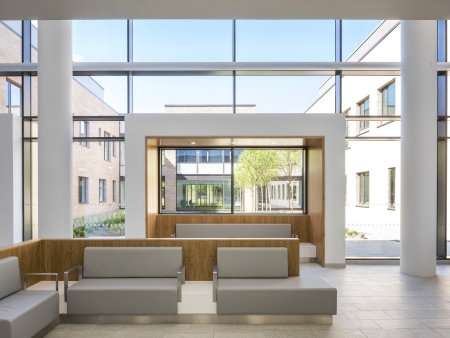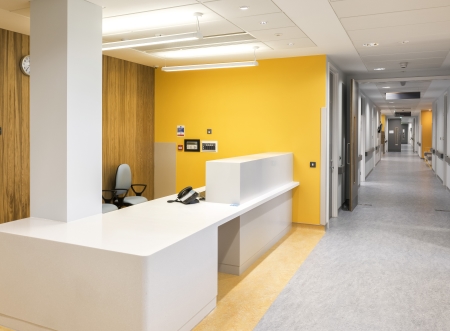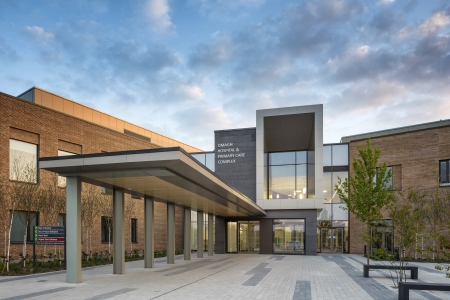TODD Architects has completed the new-build Omagh Hospital & Primary Care Complex, the first project of its kind in the UK and Ireland.
Located on a greenfield site on the outskirts of Omagh town; the new hospital provision was moulded in response to the latest healthcare reports and future initiatives; specifically designed to create a ‘natural environment for healing’ and offering short-stay services to help tackle waiting lists and bring together acute and primary services on a shared campus.
The building features:
- 40-bed en-suite wards
- Four GP practices
- Adult Allied Health Professionals (physiotherapy, speech therapy, dietetics and occupational therapy)
- Women’s and family health
- Day procedures and endoscopy unit
- Dental department
- Urgent care and treatment (minor injuries)
- Cardiac assessment
- Treatment room and GP out of hours
- Mental health services
- Children’s centre
- X-Ray (radiology)
- Outpatients/cardio and respiratory investigations
- Podiatry
- Renal department
- Hospital and community pharmacies
- Community outreach facilities
Visual presence was a key architectural factor, with the new building’s materiality, form and structure carefully designed to seamlessly blend into the tonal topographic palette of the country landscape, while also appearing prominent enough to showcase a sense of arrival and engender a level of civic pride.
The approach to the overall scale and mass of the building is that of a linear two and three-storey configuration of connected pavilions, enclosing a series of courtyard gardens. This design approach visually reduces the mass and scale and, in turn, enables a range of views ‘to’, ‘from’ and ‘between’ the main blocks to the internal courtyards and beyond to the external surroundings, enhancing the user and visitor experience.
The main entrance atrium is designed to be an active public realm foyer offering a range of spaces of differing height, functions and views, characterised by its large glazed translucent appearance, a main reception, café, retail, and waiting area.
The interlinked pavilions each define individual departments, with two main entrances: a front-of-house glazed atrium with public foyer facilities and a rear urgent care ambulance entrance.
All areas within the building are accessible from these two main entrances, which, in turn, are connected by the glazed hospital streets.
This layout was conceived to aid efficiency of functionality, guide and orientate patients, visitors and staff, while also creating a natural flow through the building.

Windows look out onto therapeutic courtyard spaces. Images courtesy of Chris Hill Photography
The principle is further extended to the individual departments where each section is colour coded by signage and furnishings to help maintain a holistic approach to wayfinding, avoiding language barriers.
The streets connecting each pavilion are fully glazed on both levels, maximising natural light while also allowing for ease of orientation and impressive panoramas of the enclosed gardens and the surrounding rivers and mountains.
Wards consist of 40 single en-suite rooms, arranged in clusters of 10 rooms around a central nursing base.
The approach to the design has carefully considered access and the balance of patient observation with privacy and the ability to have staff and patient control to suit a range of scenarios.

Individual departments are colour coded to aid with wayfinding
Catering to a mix of patient needs, both in rehabilitation and receiving palliative care, each room has access to either an external balcony view of the countryside or inwards to the courtyard gardens.
And there are a variety of room options catering for patient’s needs, including left-handed and right-handed en-suites and easier-orientated rooms for those living with dementia.
Break-out areas are interspersed throughout the hospital, designed to promote inclusiveness and to dissolve the traditional clinical barriers between staff and patients. These areas provide an informal meeting space and allow for patient-staff conservations, while also acting as an active social space for patients, staff, and visitors to relax
“Patients are remarking on the benefits of the new building,” said Dr Paul McGlinchey consultant cardiologist at the hospital.
“The new hospital has given the NHS staff of Omagh and its patients much to be enthusiastic about and I look forward to helping deliver healthcare to this area, in this new building, for years to come.”

The main entrance atrium is designed to be an active public realm foyer
